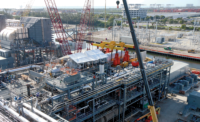Editor’s Note: This page has been updated based on clarifications provided by Regenesis Power.
Florida Gulf Coast University’s 2-megawatt single axis tracking solar photovoltaic array, built by Regenesis Power, is the first sun-tracking solar photovoltaic system installed in Florida.

An anemometer is set up onsite, and if it senses a wind speed of more than 40 mph for more than 15 seconds, a message is sent to the central controller to tell the array to store itself flat. In a flat position, the wind profile is substantially reduced.
Regenesis began work on the array in April 2009. Because of solid layers of rock found on the site, the company decided a pile foundation system, typically used with a solar installation, was neither practical nor economical.
Regenesis and structural engineer TKW Engineering worked to design a concrete foundation system, casting the pads on grade and eliminating any costly excavation.
A mock-up helped the team work out any bugs from the design and installation. The effort proved invaluable because a number of changes were made to improve the array’s appearance and function and provide easier and simpler construction techniques.
Once installation began, the team became proficient at installing the support racks and modules, eventually averaging 800 modules per day and on one occasion exceeding 1,000 units in one day.
The array is a moving machine, tracking the sun, which allows the system to produce about 20% more electricity than if the arrays were laid flat. The crux of the machine’s moving part is a screw-jack motor that pushes and pulls an actuator arm that rotates a torque tube upon which the modules are situated.
The torque tube rotates in a glass filled with acetyl bearing materials to make the operation smooth and long lasting. The design uses a galvanized steel torque arm, with 100% bolted connections, to eliminate field welding, which would have created a potential for corrosion. To date, everything has worked smoothly, and the array is almost completely silent as it rotates through its motion during the day.
The team also completed the design and installation of a 60-kilowatt solar thermal hot water system for Everglades Hall, a freshman dormitory, and the solar photovoltaic demonstration array located behind the engineering building, which is used for educational purposes.
The company finished the tracking arrays and associated projects on time and with no lost time injuries in June. Kraft Construction Co., Naples, served as the construction manager.
Key Players
Owner, Contractor, Designer: Regenesis Power
Construction Manager: Kraft Construction Co.
Engineers: Johnson Engineering, TKW Engineering, Matern Professional Engineering


